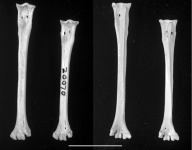Fred Ruhe
Well-known member

teven D. Emslie,& Jim I. Mead, 2023
Two New Late Quaternary Avifaunas from the East-Central Great Basin with the Description of a New Species of Falco
Western North American Naturalist. 83 (1): 33–50.
oi:10.3398/064.083.0104
Abstract
We report 2 new late Quaternary avifaunas from cave deposits in Snake Valley, White Pine County, eastern Nevada, that provide new records of extinct and extant species in the east-central Great Basin. These avifaunas collectively represent at least 24 species, including the most northern inland record of California Condor (Gymnogyps californianus) in western North America and a new species of kestrel (Falco sp.) described herein. Two extralimital living species also were identified—the Harlequin Duck (Histrionicus histrionicus) and Snowy Owl (Bubo scandiacus)—and are the first fossil records of these species in the Great Basin. We report the first radiocarbon dates on these 2 species as well as 4 new dates on Greater Sage-Grouse (Centrocercus urophasianus) and 1 on California Condor. The avifauna from these 2 sites, along with 2 other previously published late Pleistocene avifaunas from Smith Creek and Crystal Ball Cave in Snake Valley, comprise a remarkable diversity of extant, extralimital, and extinct species, especially waterfowl, shorebirds, raptors, and vultures that currently occupy a variety of communities, including coniferous forest and woodland, riparian, open sagebrush-steppe, and wetlands and lakes. This avian diversity was facilitated by climatic transitions that occurred before, during, and after the Last Glacial Maximum, when coniferous forest and woodland extended downward in elevation to areas where these caves are located. In addition, a southern arm of Lake Bonneville extended into Snake Valley, with associated wetlands and a high-stand lakeshore that existed only 3–4 km from the mouth of Smith Creek Canyon. The location of these caves placed them in an ecotone adjoining these various mixed communities; their fossil deposits add considerably to our knowledge of late Pleistocene avian communities in the eastern Great Basin.
The authors decribe Faloco powelli
Hope to find the paper so I can give more details.
Fred
Two New Late Quaternary Avifaunas from the East-Central Great Basin with the Description of a New Species of Falco
Western North American Naturalist. 83 (1): 33–50.
oi:10.3398/064.083.0104
Abstract
We report 2 new late Quaternary avifaunas from cave deposits in Snake Valley, White Pine County, eastern Nevada, that provide new records of extinct and extant species in the east-central Great Basin. These avifaunas collectively represent at least 24 species, including the most northern inland record of California Condor (Gymnogyps californianus) in western North America and a new species of kestrel (Falco sp.) described herein. Two extralimital living species also were identified—the Harlequin Duck (Histrionicus histrionicus) and Snowy Owl (Bubo scandiacus)—and are the first fossil records of these species in the Great Basin. We report the first radiocarbon dates on these 2 species as well as 4 new dates on Greater Sage-Grouse (Centrocercus urophasianus) and 1 on California Condor. The avifauna from these 2 sites, along with 2 other previously published late Pleistocene avifaunas from Smith Creek and Crystal Ball Cave in Snake Valley, comprise a remarkable diversity of extant, extralimital, and extinct species, especially waterfowl, shorebirds, raptors, and vultures that currently occupy a variety of communities, including coniferous forest and woodland, riparian, open sagebrush-steppe, and wetlands and lakes. This avian diversity was facilitated by climatic transitions that occurred before, during, and after the Last Glacial Maximum, when coniferous forest and woodland extended downward in elevation to areas where these caves are located. In addition, a southern arm of Lake Bonneville extended into Snake Valley, with associated wetlands and a high-stand lakeshore that existed only 3–4 km from the mouth of Smith Creek Canyon. The location of these caves placed them in an ecotone adjoining these various mixed communities; their fossil deposits add considerably to our knowledge of late Pleistocene avian communities in the eastern Great Basin.
The authors decribe Faloco powelli
Hope to find the paper so I can give more details.
Fred
Last edited:





